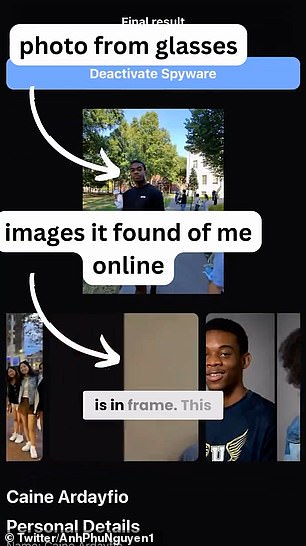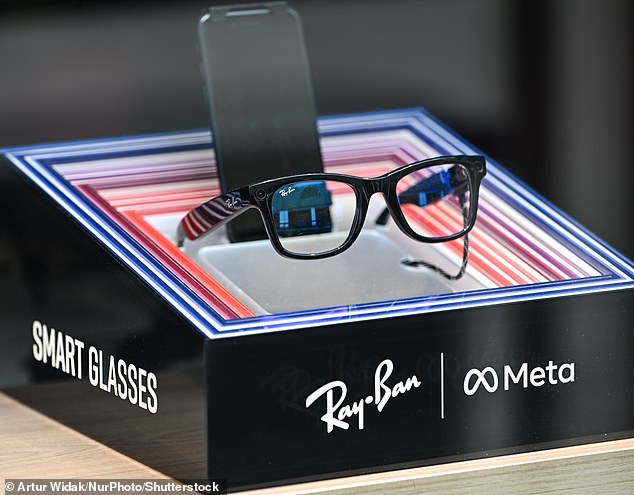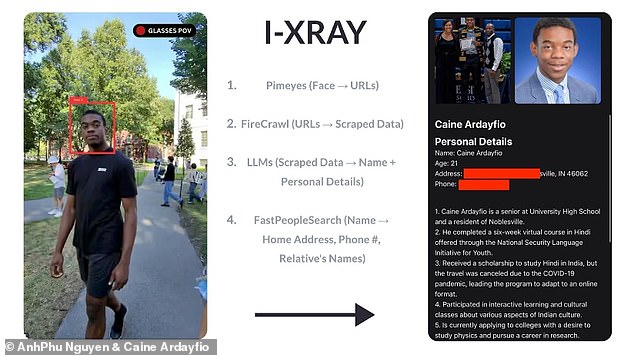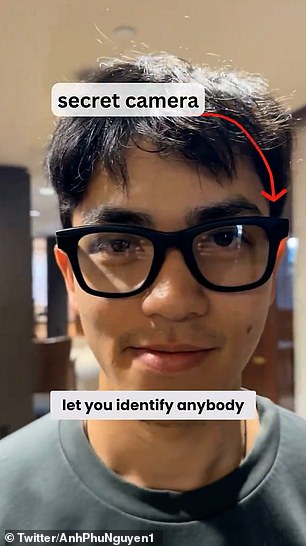Since Meta introduced its smart glasses in 2021, concerns have been raised about their ability to film people without their knowledge.
Now, two Harvard students have taken the device’s privacy-invasive capabilities even further: they created a modified version called ‘I-XRAY.’
The creepy system uses artificial intelligence and facial recognition software to instantly modify people’s identities.
In one surprising clip, students approach random strangers and quickly identify their name and other personal details, including their home address, their work history, and even their parents’ names.
It’s reminiscent of the Black Mirror episode White Christmas, where a desperate bachelor uses an implant to instantly find information about strangers online.

Dubbed I-XRAY, the spooky technology, developed by Harvard students, allows you to approach a random stranger and quickly identify them.

In the Black Mirror episode ‘White Christmas’, desperate bachelor Harry (Rasmus Hardiker) uses an implant to instantly find information about strangers online.
The technology was created by AnhPhu Nguyen and Caine Ardayfio, two engineers at Harvard University in Cambridge, Massachusetts.
“The purpose of building this tool is not for misuse and we are not going to release it,” they say in a document describing the technology.
‘Our goal is to demonstrate the current capabilities of smart glasses, face search engines, large language models and public databases.
“(We are) raising awareness that today it is possible to extract someone’s home address and other personal details simply from their face on the street.”
On X (Twitter), Nguyen posted a video of technology with the caption: “Are we ready for a world where our data is exposed at a glance?”
As the students show in the video, they use a combination of existing technology on the market to create AI glasses “that reveal anyone’s personal data just by looking at them.”
First, students grab a pair of Meta Ray Bans 2, released last year, “as they seem almost indistinguishable from regular glasses.”
With the touch of a button on the side of the specs, these glasses can film up to three minutes of live video, which can be streamed to Instagram.

The students grabbed a pair of Meta Ray Bans 2, released last year, “as they seem almost indistinguishable from regular glasses.”
The live-streamed images are monitored by a program called PimEyes, described as a “reverse image search tool.”
By monitoring the live stream, PimEyes can match a face to publicly available images of that face on the Internet, the duo explains.
Once their faces are found, an AI is asked to take details such as the person’s name, their occupation, and other personal details that may accompany that image.
I-XRAY uses FastPeopleSearch, an online tool that only needs a person’s name to find more personal information, such as home addresses, phone numbers, age and family members, in publicly available social media records and profiles.
“Everything feeds back to an app we write on our phone,” Nguyen says in the video, posted on X.
I-XRAY is unique, engineers say, because it works fully automatically, allowing the user to quickly find information about the people they encounter.
The video shows students approaching strangers on campus, on the street and in the Harvard subway station in Cambridge.

Experts say: ‘Initially started as a side project, I-XRAY quickly highlighted significant privacy concerns. “The purpose of creating this tool is not for misuse and we will not publish it.”

Meta introduced the £299 glasses during the Meta Connect conference last year.
In one case, Ardayfio approaches a woman he has never met before and asks, ‘Are you Betsy? I think I met you through the Cambridge Community Foundation.
Smiling, the woman (presumably believing she had met him before but forgotten) confirms that she is actually Betsy and they begin a conversation.
Fortunately, it is possible to remove your data from PimEyes and FastPeopleSearch so that I-XRAY or any similar system cannot identify you.
Students provide links in their document that provide step-by-step instructions on how to do this so “you and your loved ones can protect yourself.”
Meta has been contacted for comment.

